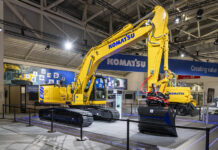Safety is one of the most talked about topics today. Almost every phone call, skype or email is signed off with the words, stay safe. The government guidelines implemented to keep workers providing essential services safe during the lockdown have had some effect. However, now that the wide-scale restrictions are lifted and the construction industry gears up again, how can we continue to safeguard workers on sites? Here George Ionescu, senior product manager at Finning UK & Ireland, explains how machine technology can help to protect construction workers on site today and in the future.
Construction is one of the most dangerous sectors to work in. According to latest figures from the Health and Safety Executive (HSE), there were 54,000 work-related injuries recorded in the construction sector during 2018/19 with 12 per cent involving some sort of collision or accident with a vehicle or machine. The statistics suggest a clear need for increased safety measures and better awareness of the risks for those working in the sector.
One area where the industry is making a difference is with the machines themselves, and improvements in technology are helping manufacturers to do this. Caterpillar has introduced a range of technology-based safety features to its Cat 360° excavators that mitigate the risk of injury to the operator and wider site workers.
The application of electro-hydraulic controls as a standard feature on all machines is the first step towards universal remote-control operation. The electro-hydraulic controls allow the installation of an optional remote-control kit to all excavators. This will mean operators will be able to control the excavator from outside the cab, at a safe distance, and will be especially beneficial for those working in the more dangerous environments of demolition sites and quarries where a large proportion of accidents occur.
The new packages, which will be launched later this year, are available for a range of models from small excavators up to the larger machines operating between 52 and 95 tonnes. It includes the Cat 313 GC 15 tonne, Cat 315, Cat 352, Cat 374 and Cat 395 excavators. The addition of remote-control capabilities paves the way for the next phase in the evolution of the excavator. And although still a way off, fully autonomous machines are likely to make their way into the mainstream construction sector before 2030.
Another key safety feature that is available to install on all Cat machines is the birds-eye view camera. Coming as an add-on option for any machine, the camera provides the operator with a clear 360° view around the outside of the excavator, feeding live images directly to the screen display in the cab. Affordable and easy to install, this add-on provides contractors with an off-the-shelf solution that can increase operator and site worker safety. It can also be installed at any point during a machine’s operational life.
The third key safety feature available from Cat, and now fitted as standard on all excavators is called E-Fence. The system enables operators to set specific safety boundaries around the exterior of the excavator including height, depth, front end and swing. Once these parameters are set, there is an integral safety feature that ensures the machine does not pass out of the safe zone, even if the operator pushes the joystick to exceed the set limit. Finning has a series of videos available on each of the four key E-Fence features and will be sharing them across its social media channels so customers can skill up during lock down.
The construction industry is under great pressure today to deliver projects on time, efficiently and within tight budgets. The safety of workers on site, however, is paramount and is one area where the sector cannot afford to cut costs. Although technology is playing a key role in safeguarding contractor safety, it’s imperative that those operating machines and working on sites are adequately skilled so as to reduce the risk of accidents.











